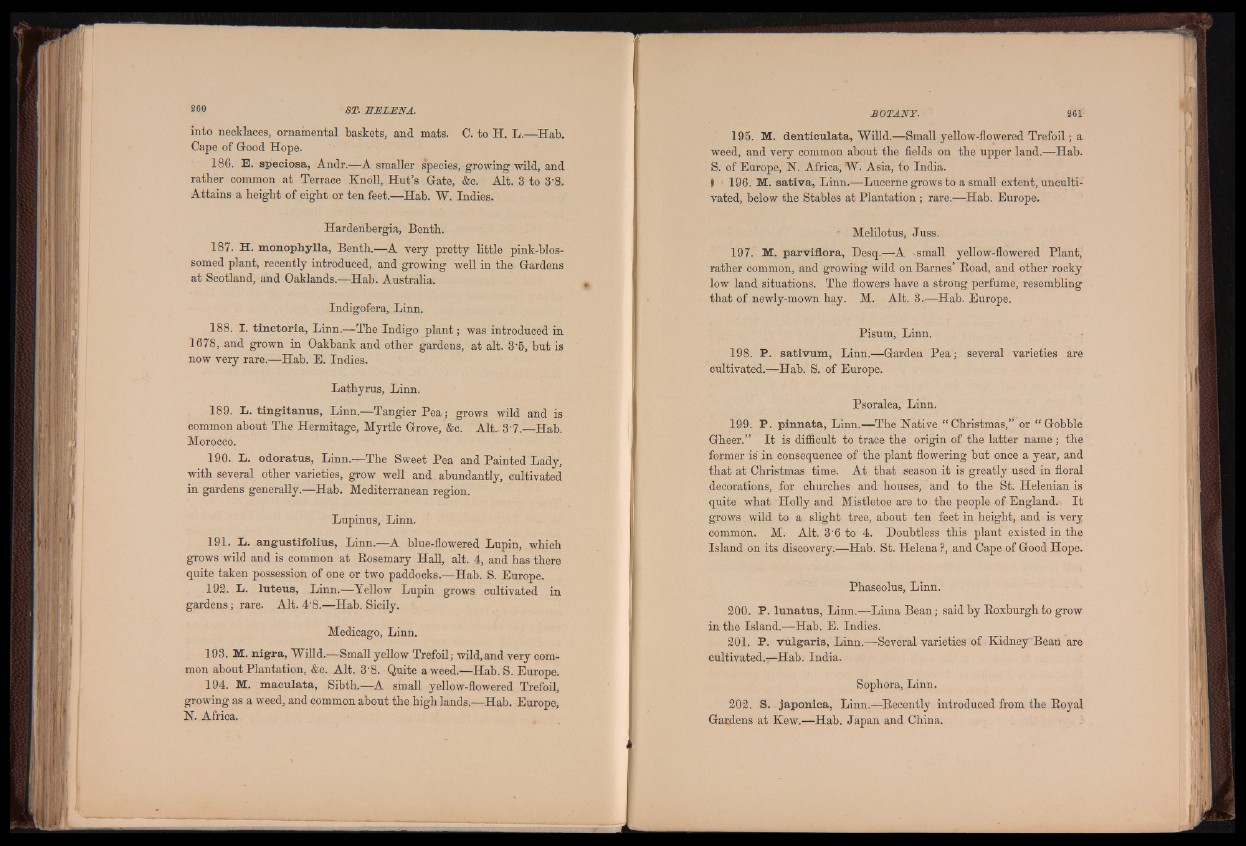
into necklaces, ornamental baskets, and mats. C. to H. L.—Hab.
Cape of Good Hope.
186. E. speciosa, Andr.—A smaller species, growing wild, and
rather common at Terrace Knoll, Hut’s Gate, &c. Alt. 3 to 3'8.
Attains a height of eight or ten feet.—Hab. W. Indies.
. Hardenbergia, Benth.
187. H. monophylla, Benth.—A very pretty little pink-blossomed
plant, recently introduced, and growing well in the Gardens
at Scotland, and Oaklands.—Hab. Australia.
Indigofera,. Linn.
188. I. tinctoria, Linn.—The Indigo p lan t; was introduced in
1678, and grown in Oakbank and other gardens, at alt. 3 5 , but is
now very rare.—Hab. E. Indies.
Lathyrus, Linn.
189. L. tingitanus, Linn.—Tangier Pea; grows wild and is
common about The Hermitage, Myrtle Grove, &c. Alt, 3 7 .—Hab.
Morocco.
190. L. odoratus, Linn.—The Sweet Pea and Painted Lady,
with several other varieties, grow well and abundantly, cultivated
in gardens generally.—Hab. Mediterranean region.
Lupinus, Linn.
191. Ti. angustifolius, Linn.—A blue-flowered Lupin, which
grows wild and is common at Rosemary Hall, alt. 4, and has there
quite taken possession of one or two paddocks.—Hah. S. Europe.
192. L. luteus, Linn.—Tellow Lupin grows cultivated in
gardens; rare. Alt. 4'8.—Hab. Sicily.
Medicago, Linn.
193. M. nigra, Willd.—Small yellow Trefoil; wild,and very common
about Plantation, &c. Alt. 3'8. Quite a weed.—Hab. S. Europe.
194. M. maculata, Sibth.—A small yellow-flowered Trefoil,
growing as a weed, and common about the high lands.—Hab. Europe,
N. Africa.
195. M. denticulata, Willd.—Small yellow-flowered Trefoil; a
weed, and very common about the fields on the upper land.—Hab.
S. of Europe, N. Africa, W. Asia, to India.
I . 196. M. sativa, Linn.—Lucerne grows to a small extent, uncultivated,
below the Stables at Plantation; rare.—Hab. Europe.
Melilotus, Juss.
197. M. parviflora, Desq.—A -small yellow-flowered Plant,
rather common, and growing wild on Barnes’ Road, and other rocky
low land situations. The flowers have a strong perfume, resembling
that of newly-mown hay. M. Alt. 3.—Hab. Europe.
Pisum, Linn.
198. P. sativum, Linn.—Garden Pea; several varieties are
cultivated.—Hab. S. of Europe.
Psoralea, Linn.
199. P. pinnata, Linn.—The Native “ Christmas,” or “ Gobble
Gheer.” I t is difficult to trace the origin of the latter name; the
former is' in consequence of the plant flowering but once a year, and
that at Christmas time. At that season it is greatly used in floral
decorations, for churches and houses, and to the St. Helenian is
quite what Holly and Mistletoe are to the people of England. I t
grows wild to a slight tree, about ten feet in height, and is very
common. M. Alt. 3'6 to 4. Doubtless this plant existed in the
Island on its discovery.—Hab. St. Helena ?, and Cape of Good Hope.
Phaseolus, Linn.
200. P. lunatus, Linn.—Lima Bean; said by Roxburgh to grow
in the Island.—Hab. E. Indies.
201. P. vulgaris, Linn.—Several varieties of Kidney Bean are
cultivated.—Hab. India.
Sophora, Linn.
202. S. japonica, Linn.—Recently introduced from the Royal
Gardens at Kew.—Hab. Japan and China.